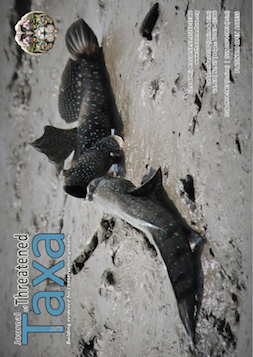Distribution of Syzygium travancoricum Gamble (Myrtaceae), a Critically Endangered tree species from Kerala part of Western Ghats, India
Main Article Content
Abstract
Syzygium travancoricum Gamble is an endemic, Critically Endangered tree species found in marshy swamps of the Western Ghats. An assessment was conducted on existing distribution pattern and population structure of this species in Kerala. Most of the existing populations are mainly located in sacred groves and this tree is an ideal example on role of sacred groves in conserving biodiversity especially IUCN red listed species. A total of 465 individuals were recorded in which maximum number of sapling density was recorded in Kalasamala Sacred grove followed by patches of Myristica swamps in Kulathupuzha. Fragmentation of populations, habitat modification, over exploitation, pollution and invasion of exotics are major threats to S. travancoricum. Hence urgent intervention is required for restoration programmes, management of habitat and subsequently delisting this species from IUCN red list of threatened species.
Article Details

This work is licensed under a Creative Commons Attribution 4.0 International License.
Authors own the copyright to the articles published in JoTT. This is indicated explicitly in each publication. The authors grant permission to the publisher Wildlife Information Liaison Development (WILD) Society to publish the article in the Journal of Threatened Taxa. The authors recognize WILD as the original publisher, and to sell hard copies of the Journal and article to any buyer. JoTT is registered under the Creative Commons Attribution 4.0 International License (CC BY), which allows authors to retain copyright ownership. Under this license the authors allow anyone to download, cite, use the data, modify, reprint, copy and distribute provided the authors and source of publication are credited through appropriate citations (e.g., Son et al. (2016). Bats (Mammalia: Chiroptera) of the southeastern Truong Son Mountains, Quang Ngai Province, Vietnam. Journal of Threatened Taxa 8(7): 8953–8969. https://doi.org/10.11609/jott.2785.8.7.8953-8969). Users of the data do not require specific permission from the authors or the publisher.
References
Bourdillon, T.F. (1908). The Forest Trees of Travancore. The Travancore Government Press, Trivandrum, xxxii+456pp.
Byng, W.J., P.G. Wilson & N. Snow (2015). Typifications and nomenclatural notes on Indian Myrtaceae. Phytotaxa 2: 101–116.
Chandran, M.D.S., D.K. Mesta, G.R. Rao,S. Ali, K.V. Gururaja & T.V. Ramachandra (2008). Discovery of Two Critically Endangered Tree Species and Issues Related to Relic Forests of the Western Ghats. The Open Conservation Biology Journal 2: 1–8. https://doi.org/10.2174/1874839200802010001
Chandran, M.D.S., G.R. Rao, K.V. Gururaja & T.V. Ramachandra (2010). Ecology of the swampy relic forests of Kathalekan from central Western Ghats, India. Bioremediation, Biodiversity and Bioavailability, Global Science Books 4: 54–68.
Gamble, J.S. (1919). Flora of the Presidency of Madras, Adlard and Son, Ltd., London, 480pp. https://doi.org/10.5962/bhl.title.21628
Govaerts, R.H.A., M. Sobral, P. Ashton, F.R. Barrie, B.K. Holst, L. Landrum, K. Mastsumoto, F.F. Mazine, E.M.N. Lughadha, C.E.B. Proenca, L.H. Soares-Silva, P.G. Wilson & E. Lucas (2008). World Checklist of Myrtaceae, Royal Botanic Gardens, Kew, London. Assessed on 03 April 2019. http:// apps.kew.org/wcsp.
IUCN (2017). The IUCN Red List of Threatened Species. Version 2. Downloaded on 05 May 2018.
IUCN (2019). The IUCN Red List of Threatened Species. Version 2019-2.Downloaded on 11 May 2020.
Karuppusamy, S. & V. Ravichandran (2016). Diversity Assessment of Woody Plants of Megamalai Wildlife Sanctuary, Theni District, Tamil Nadu. Bio Bulletin2: 74–89.
Nair, N.C. & C.N. Mohanan (1981). On the rediscovery of four threatened species from the sacred groves of Kerala. Journal of Economic and Taxonomic Botany 2: 233–235.
Parnell, J.A.N., L.A. Craven & E. Biffin (2007). Matters of scale: Dealing with one of the largest genera of angiosperms, pp. 251-274. In: Hodkinson, T. & J. Parnell (eds.). Reconstructing the Tree of Life, Taxonomy and Systematics of Species Rich Taxa. Boca Raton, FL. Taylor & Francis, 368pp. https://doi.org/10.1201/9781420009538
Prabhugaonkar, A., D.K. Mesta & M.K. Janarthanam (2014). First report of three red-listed tree species from swampy relics of Goa State, India. Journal of Threatened Taxa 6(2): 5503–5506. https://doi.org/10.11609/JoTT.o3376.5503-6
Ray, R. (2011). Developing Strategies for Conservation of Threatened Endemic Biodiversity of the Sacred Groves of central Western Ghats Project report. Centre for Ecological Sciences, Indian Institute of Science, Bangalore.
Robi, T.J. (2009). Floristic structure and diversity of Myristica swamps at Kulathupuzha in a GIS perspective. Dehradun University, viii+148pp.
Sasidharan, N. (2004). Biodiversity Documentation for Kerala Part 6: Flowering Plants. Kerala Forest Research Institute, Peechi, 702pp.
Sujanapal, P. & C. Kunhikannan (2017). The Genus Syzygium in Western Ghats. In: Nair, K.N. (ed.).The Genus Syzygium: Syzygiumcuminiand Other Underutilized Species. Taylor & Francis, Boca Raton, FL, 288pp. https://doi.org/10.1201/9781315118772
Udhayavani, C., V.S. Ramachandran & H.A. John (2013). Ecology and population study on Syzygium travancoricum Gamble (Myrtaceae) - A critically endangered species from Nilgiris. NeBIO 4: 68–71.

